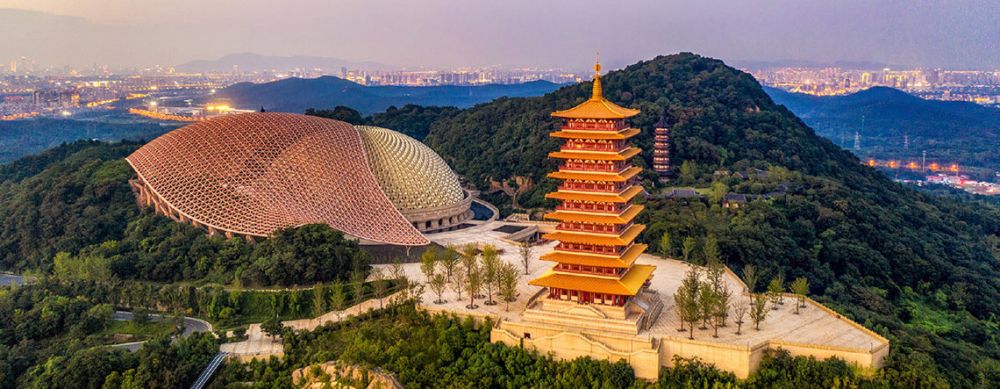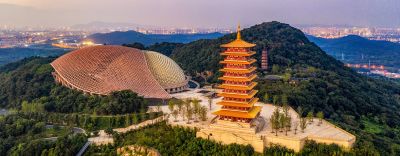

The Nanjing Massacre Memorial Hall is a solemn tribute to one of World War II's most brutal events, the Nanjing Massacre, also known as the Rape of Nanking. Visitors at the hall can expect a moving and educational experience as they walk through exhibitions displaying historical artifacts, photographs, and testimonies that tell the story of the tragedy that unfolded in 1937. The memorial hall offers a narrative that is both poignant and comprehensive, detailing the historical context, the harrowing events, and the aftermath of the massacre. Additional features such as the statue of peace, the wall of names, and the eternal flame provide spaces for reflection and remembrance. While the subject matter is heavy, the museum handles it with a level of respect and sensitivity that promotes understanding and peace.
Xuanwu Lake Park is a scenic destination that provides a welcome escape from the bustling city life of Nanjing. Located at the foot of Zhongshan Mountain, the park features five interconnected islands, each with its distinctive charm and attractions including temples, pagodas, and traditional Chinese gardens. Visitors can stroll along the pathways lined with beautiful trees and flowering plants, enjoy a leisurely boat ride on the lake, or simply sit and admire the picturesque landscape. The park is also a popular spot for outdoor activities like jogging, picnicking, and flying kites. With the majestic backdrop of the ancient city wall and the seasonal changes that transform the park’s appearance, Xuanwu Lake Park is a location where history intertwines with natural beauty, offering a peaceful and enjoyable experience for all who venture within its green embrace.
Zhonghua Gate, or 'China Gate,' stands as the best-preserved and largest castle-style gate in China. It's a key component of the Nanjing City Wall and a testament to the Ming Dynasty's architectural might. The gate has a complex system of enemy-trapping chambers, adding an intriguing military engineering aspect to your exploration. Visitors can walk through the gate's multiple archways and ascend its platforms to gain a perspective on how the city was defended against invaders. The panoramic views of Nanjing from atop the gate are breathtaking, and while there, one can immerse themselves in the city's rich historical narrative. This iconic landmark is not just a gateway into the past but also a symbol of the endurance and strength of the Chinese spirit throughout history.
The Confucius Temple, also known as Fuzi Miao, is not only a temple dedicated to the great philosopher Confucius but also a bustling area surrounding it, filled with shops, restaurants, and a myriad of tourist activities. The area serves as a cultural marketplace where one can find a wide collection of traditional Chinese crafts, souvenirs, and snacks. In the evenings, the place comes alive with its brilliant lights and vibrant atmosphere. Traditional performances often take place, and boat rides along the Qinhuai River offer a romantic glimpse of Nanjing's past. Exploring the Fuzi Miao area is a sensory delight, with the aroma of local cuisine, the harmonious sounds of music, and the delightful sights of ancient architecture, promising a memorable and culturally rich experience for every visitor.
The Sun Yat-sen Mausoleum is a site of immense historical importance and a tribute to Dr. Sun Yat-sen, the revered founder of the Republic of China. Situated at the foot of Purple Mountain, the mausoleum features a grand marble staircase leading to a stately hall, where a statue of Sun Yat-sen is seated. The surrounding scenery is one of tranquility and grandeur, with lush greenery and architectural elegance. Visitors to the mausoleum can learn about the life and legacy of Sun Yat-sen through exhibitions and the informative plaques that line the area. The climb to the mausoleum is a symbolic journey, reflecting the upward struggle and eventual triumph of Sun Yat-sen's revolution. Despite often being crowded with tourists and local visitors, the mausoleum maintains an atmosphere of respect and solemnity, making it a must-visit attraction to understand China's modern history.
Nestled on the slopes of Purple Mountain, the Purple Mountain Observatory is recognized as China's first modern astronomical observatory. Established in 1934, this institution has contributed significantly to the field of astronomy and is still actively involved in astronomical research. Visitors have the unique opportunity to look through some of the telescopes used by professional astronomers and explore various exhibits that cover topics like space exploration, celestial bodies, and the history of astronomy in China. The observatory's location provides an exceptional vantage point for both daytime and nighttime sky watching, making it an ideal destination for science enthusiasts and curious minds. The serene setting and scientific atmosphere create an environment that inspires awe and wonder, further enhanced by the historical significance of the telescopes and artifacts on display at the observatory.
The Ming Xiaoling Mausoleum is the burial site of the Hongwu Emperor, the founder of the Ming Dynasty. It features a grand gateway called the Golden Water Bridge, leading to an impressive avenue lined with stone statues of animals and officials. The mausoleum complex showcases the exquisite craftsmanship and architectural knowledge of the Ming Dynasty era. As visitors explore this UNESCO World Heritage site, they are transported back in time, walking paths carved hundreds of years ago. Each stone animal and each building tells a story of China's imperial past, of its rituals, beliefs, and the pursuit of eternal peace for the departed emperor. The serenity and significance of the site offer a profound connection to the ancient dynastic world and a deeper appreciation for China's cultural and historical legacy.
The Jinling Scripture Printing House, also known as Da Bao En Si Scripture Printing House, is an establishment steeped in history and culture. This place is famous for its ancient technique of printing sutras and classical texts using traditional wooden blocks. Visitors can witness the preservation of this age-old craft, which is an Intangible Cultural Heritage. The complex includes exhibitions demonstrating the production process from carving the wooden blocks to the manual assembly of printed pages. Observing these processes provides a unique insight into the meticulous attention to detail and dedication required to maintain this tradition. Beyond the technical aspects, the venue itself is a serene environment filled with the rich heritage of China's literary and religious texts, offering a peaceful retreat for those looking to immerplain themselves in the scholarly atmosphere and historic significance of the printing house.
The Nanjing Museum is one of the first and largest museums established in China. It offers a vast collection of artifacts, ranging from ancient pottery to Ming Dynasty jade pieces, illustrating the rich tapestry of Chinese history. Visitors can explore various exhibitions displaying art, textiles, porcelain, and more, each with its unique story reflecting different epochs of China’s civilization. The museum's architecture is a delightful blend of traditional and modern styles, enhancing the overall cultural experience. Engaging multimedia displays and interactive installations provide an accessible way for visitors of all ages to learn about the historical and cultural developments that have shaped China. The Nanjing Museum is not just a treasure trove of historical items; it is a dynamic cultural institution that reflects China’s journey through the ages, providing a comprehensive and captivating look at the country's artistic and historical evolution.
Laomendong Historic District is a charming area in Nanjing that exemplifies the city's old-world ambience blended with modern vitality. This historic neighborhood, once a part of the southern part of the old city, has been revitalized to showcase traditional architecture, culture, and local crafts. As visitors wander through the cobblestone streets, they encounter artisanal shops, teahouses, and quaint eateries that offer a taste of local cuisine. Laomendong also serves as a cultural hub with regular events such as open-air markets and performances that invoke the spirit of old Nanjing. During a stroll in Laomendong, one not only steps back in time to experience the lifestyle of a bygone era but also feels the pulse of contemporary creativity, making it a must-visit for those looking to immerse themselves in Nanjing's living history.
